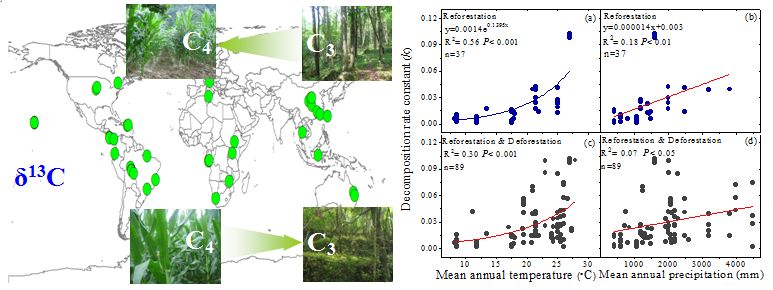Researchers Revealed the Relevance between SOC Dynamics and Climatic Factors
2015-03-23
Globally, soils contain 1500-2300 Pg of organic carbon (C), approximately twice as much as the amount in the atmosphere and three times the mount in terrestrial vegetation. Any small change in the soil organic C (SOC) pool could potentially affect atmosphere CO2 concentration and regional or global C balance. Climatic factors, e.g., temperature and precipitation, may directly or indirectly impact SOC dynamics. Although several studies have examined the effects of mean annual temperature on SOC decomposition, the debate remains due to apparently contradictory results in previous studies.
A research group led by Prof. ZHANG Quanfa from Wuhan Botanical Garden synthesized the results from published data as well as this group’s observations in China’s Qinling Mountains. Based on the 13C natural abundance analysis, this group evaluated the dynamics of new and old C in top soil following land-use change, and analyzed the relationships between SOC decomposition rates and climatic factors.
They found that SOC decomposition rates increased significantly with mean annual temperature and precipitation in the reforestation sites and the mean annual temperature explained 56% of variation in SOC decomposition rates by exponential model. These results imply that global warming may accelerate soil organic matter (SOM) decomposition.
“Worldwide land-use changes involving conversion of vegetation with different photosynthetic pathways (e.g., C3 and C4) offer a unique opportunity to quantify SOM decomposition rate and its response to climatic conditions by using stable isotope techniques”, said by Prof. ZHANG Quanfa, “Based on the analysis of data compiled from vegetation conversions studies, Giardina and Ryan found that SOC decomposition rates did not vary with mean annual temperature in 2000. They published their discovery in the famous journal Nature. Their results have been highly cited and have been usually taken as evidence that the decomposition of SOC is insensitive to change in mean annual temperature. Interestingly, our results did not agree with the conclusions of Giardina and Ryan. The main reasons for Giardina and Ryan’s mistake were that they did not consider the effects of soil depth and differentiate the observations from reforestation and deforestation sites. ”
Researchers also estimated the “switch time” from the regression equations of proportions of old soil C vs. years since land-use change. They found that it took 45.4 years and 43.4 years for reforestation and deforestation respectively, when the proportion of new soil C exceeded the proportion of old soil C.
This research was supported by the National Natural Science Foundation of China, the Chinese Academy of Sciences, and the National Key Technology Research and Development Program. Results were published in Global Change Biology (doi: 10.1111/gcb.12886) online entitled “Soil carbon dynamics following land-use change varied with temperature and precipitation gradients: Evidence from stable isotopes”.

Relationships between the SOC decomposition rates and climatic factors (Image by WBG)